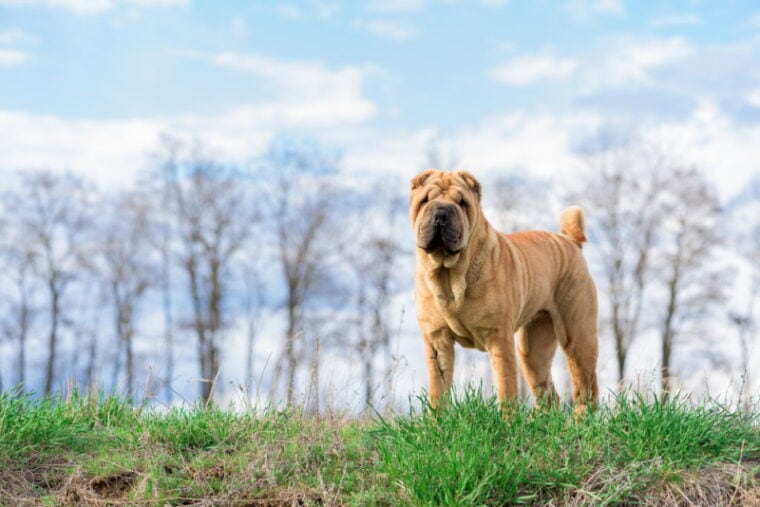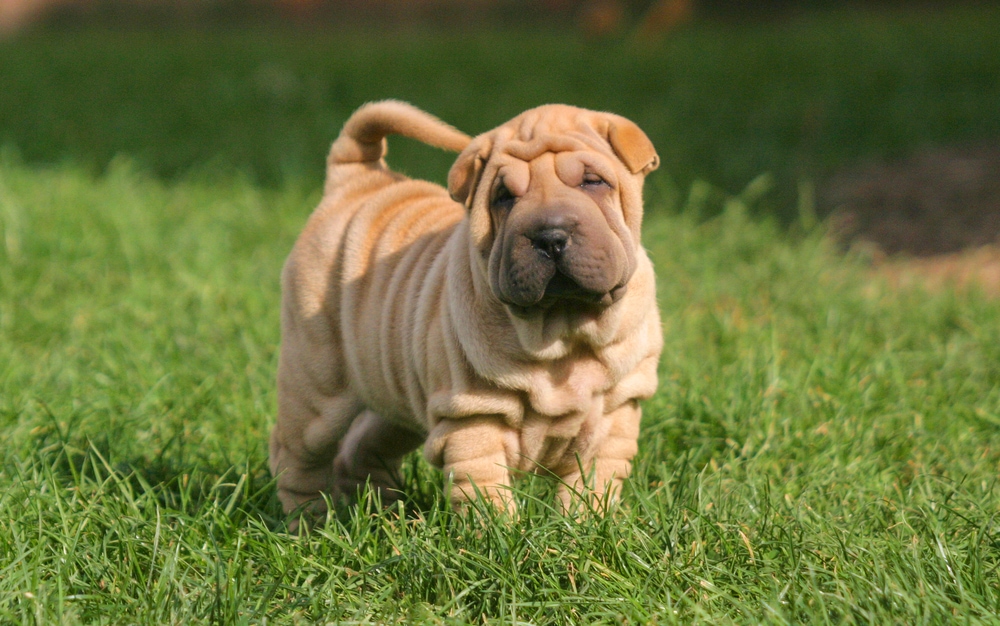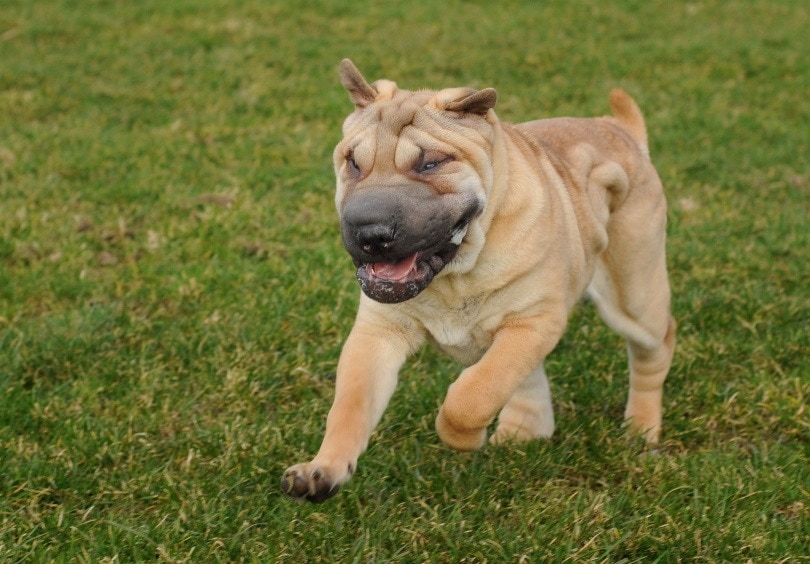
Click Below to Skip Ahead
China is home to some phenomenal dog breeds, creating many that we know and love today. The Shar-Pei is no exception—this dog could win awards with their wrinkle formation and adorably squishy expressions.
Breed Overview
Height:
12 – 18 inches
Weight:
14 – 23 pounds
Lifespan:
15 – 35 pounds
Colors:
White, blue, silver, red, brown, gray, black
Suitable for:
Active families, those looking for a low-shedding dog
Temperament:
Loyal, loving, intelligent, easy to train, friendly, gets along with other pets
But even though these dogs look like cuddly stuffed animals, they are actually quite serious with particular temperaments. So now that the looks have your attention—is the Shar-Pei a good match for your household? Let’s find out all about them!
Shar-Pei Characteristics
 Shar-Pei Puppies
Shar-Pei Puppies

Shar-Peis are a relatively prevalent breed, so securing a breeder won’t be very difficult in most cases. But it might still require some travel. Be sure to check out breeders in your state or surrounding areas. You could also find plenty of Shar-Pei and Shar-Pei mixes at local rescues and shelters. These dogs are often adults, but in some cases, a litter of puppies might come up. Adopting an adult dog might be challenging since this breed is a little particular. You need to make sure all members of your household, including current pets, are compatible with your new potential companion.
Shar-Peis can be pretty stubborn, making training a challenging task for some. They are highly intelligent, but they will need consistent and firm training sessions. They also need enough physical and mental stimulation to avoid boredom or aggressive behaviors.
Temperament & Intelligence of the Shar-Pei

The Shar-Pei builds incredible bonds with their people. They are very protective, attentive, and affectionate. You can guarantee that if you’re down, your loyal furry friend will be at your side through every turn.
This dignified breed doesn’t really have time for reindeer games—they’re pretty serious individuals. That doesn’t mean they aren’t playful puppies or won’t enjoy fetching in the yard. But at home, they tend to be relaxed and focused.
These dogs can be fiercely independent, so early training is a must. They can be a little headstrong and stubborn, even sometimes having a power struggle. But once they learn the hierarchy, they happily oblige.
Even though these dogs are magnificent family members, they are notoriously wary of strangers. These dogs will need lots of exposure to different animals and people, so they understand the difference between a territorial threat and a friend.
Are These Dogs Good for Families? 👪
Shar-Peis make wonderful family companions. When they are raised with a family, they bond very well with every individual, creating a strong lifelong relationship.
A Shar-Pei would work well in a single-person household or a large family—they can mesh with just about any lifestyle. Do take note that these pets might pose a bite risk in urban areas if they aren’t properly fenced in. So, make sure you can arrange proper reinforcements.
Because the Shar-Pei tends to be serious-natured, they might do best in households with children six and older.
A mannerly, well-trained Shar-Pei would work very well for an older adult. However, more aggressive, territorial, or rambunctious Shar-Peis might pose some challenges.
Does This Breed Get Along with Other Pets?
A Shar-Pei can be choosy about who they become friends with. They tend to be suspicious and territorial by nature. Many can still be same-sex aggressive even after being spayed or neutered.
However, these dogs usually do fine when acclimated early. It’s best if they grow up with another dog instead of another dog coming along after. But with the right temperament, it’s totally doable in most situations if you introduce it correctly.
Shar-Peis can be predatory with cats, but you might be able to avoid it if you introduce them as puppies. They should never (as no dog should) be left with smaller prey animals. Also, they might not be the best candidates to be around livestock, especially ducks and chickens.
 Things to Know When Owning a Shar-Pei:
Things to Know When Owning a Shar-Pei:
Food & Diet Requirements 🦴
As a breed, Shar-Peis can often suffer from allergies of all kinds. To avoid any triggers, you should introduce them to a solid, filler-free diet with as many natural ingredients as possible. Try to go with a protein-rich meal that has easily traceable ingredients.
It would be best if you fed your Shar-Pei quality puppy chow until they reach the age of transition. Any dog food you offer should meet the AAFCO requirements for canines. While many prefer wet food, dry kibble, or a combination, diet options for dogs change rapidly.
As time goes on, more owners are transitioning to a much more natural diet selection for their furry family members. They’re hopping on bandwagons to get fresh crafted recipes delivered right to their doors, tailored to meet the dietary needs of their dogs.
Some pet parents also are trying their hand in the kitchen, tossing together a medley of fresh ingredients to feed their pets in the form of raw or lightly-cooked fresh meals.
Before you decide, you should speak with your vet about their personal recommendations for the breed.
Exercise 🐕
Shar-Peis are alert and sharp—and they love to practice these skills. Your Shar-pei will need lots of exercise. And keep in mind that with this breed, mental exercise is just as important as physical.
While Shar-Peis are young, they generally need about an hour of exercise a day. Their desire for activity wanes as they age, especially after they are spayed or neutered.
Training 🎾
Shar-Peis can be challenging to train—but not because of a lack of intelligence. You could say it’s too much sometimes. While they are eager to please, they are also stubborn.
So sometimes, when you make a request, it might not sound as fun as what they had in mind. Positive reinforcement with firmness is crucial when training this breed.
If you find you’re in over your head, you can consider professional training. With the proper steps taken, you can have an obedient, mannerly Shar-Pei that respects your decision-making capabilities.
When it comes to basic commands and house training, these smart little pups should have no trouble catching on.
Grooming ✂️
Shar-Peis have unique grooming needs that differ from many other breeds. As you know from the adorable photos, Shar-Peis are covered in wrinkles. While this is the epitome of cuteness, bacteria hide in this layer.
As the bacteria grow from the moisture of the skin folds, it causes a plaque-like build-up that can cause infection. Owners must regularly clean the folds of skin with a baby wipe or wet cloth.
Shar-Peis shed pretty steadily, and they have super thick coats. As you can imagine, there’s a lot of hair in the home. To avoid sweeping and vacuuming up hair all the time, it’s good to brush your Shar-Pei daily.
Keep up with regular baths, which should occur every four to six weeks. This breed will need coat upkeep more than most because the bacteria in their skin folds not only cause infection,
Health and Conditions 🏥
During your pup’s first year of life, they will get to know their vet pretty well. You’ll have to keep up with vaccines, boosters, treatments, and spay or neuter surgery. Afterward, visits will trim down to being annually, permitting your pup is fit and healthy.
Shar-Peis has a few breed-related health concerns to watch for. The best way to avoid any developing health issue is to prevent it completely by ensuring routine vet care, proper diet, and regular exercise.
 Male vs Female
Male vs Female
Male Shar-Peis are sharp, protective, territorial, and loyal. These dogs are likely very wary of strangers and other dogs they perceive as threats. They weigh 55 to 60 pounds and stand 18 to 20 inches tall.
Female Shar-Peis are affectionate, discerning, motherly, and often dominant. They might not do well in same-sex pairings, though this isn’t always the case. Females weigh between 45 and 55 pounds and stand 17 to 19 inches tall.
Both male and female Shar-Pei dogs share basic traits. However, males are larger, bulkier, and sometimes more aggressive than females.
3 Little-Known Facts About the Shar-Pei
1. Shar-Pei wrinkles aren’t for looks.
Even though one thing that attracts you to this breed is their adorable wrinkles, they have a purpose. Rather than being super squishy, they act as a layer of protection for the dog.
In ancient history, the Shar-Pei was used in the fighting ring. Loose skin made it more possible to be in a risky situation and still get away with its organs intact if it was bitten.
2. Life Magazine brought the Shar-Pei back from the brink of extinction.
Mango Law was a Shar-Pei breeder who tried to revive the breed in the 1970s. Life Magazine helped the breeder make this possible by slapping an irresistibly cute Shar-Pei on the cover of one of their issues. Needless to say, demand rose dramatically after.
3. The Shar-Pei was once the rarest breed in the world.
In the 1940s, China turned over to communism. During this transition, the government enforced nearly unpayable taxes on all dogs, causing the breed to go extinct nearly.
 Final Thoughts
Final Thoughts
Shar-Peis might be a bit of a challenge for some owners but not others. Keep in mind—these dogs are incredibly affectionate and loyal. However, some might develop aggressive or territorial issues at some point. As an owner, you must be prepared to find solutions before a problem arises.
If a Shar-Pei sounds like a good breed match, it’s time to look around for a reputable breeder. If you’re feeling like giving an animal a second chance, don’t forget to look at shelters and rescues near you. Best of luck in your search.
See Also:
Featured Image Credit: taranova oxana, Shutterstock

 Shar-Pei Puppies
Shar-Pei Puppies Things to Know When Owning a Shar-Pei:
Things to Know When Owning a Shar-Pei: Male vs Female
Male vs Female



